Malhar Rao Holkar
| Malhar Rao Holkar | |
|---|---|
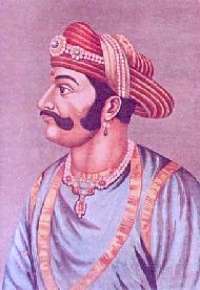 Malhar Rao Holkar | |
| Born |
16 March 1693 Jejuri, Pune District |
| Died | 20 May 1766 (aged 73) |
| Allegiance |
|
| Rank | Subedar / Peshwa's chief general [1] |
| Relations |
Bai Sahib Holkar (wife) Bana Bai Sahib Holkar (wife) Dwarka Bai Sahib Holkar (wife) Harku Bai Sahib Holkar (wife) Khanderao Holkar (Son) Ahilyabai Holkar (Daughter-in-law) Malerao Holkar II (Grandson) Two daughters Bhojirajrao Bargal (uncle) |
Malhar Rao Holkar (16 March 1693 – 20 May 1766) was a noble of the Maratha Empire, in present-day India. Malhar Rao is particularly known for being the first Maratha Subhedar of Malwa in Central India. He was the first prince from the Holkar family which ruled the Indore State. He was one of the early officers to help spread the Maratha rule to northern states and was given the state of Indore to rule by the Peshwas.
Early life
Malhar Rao Holkar was from the Dhangar community, a pastoral group that is not technically a part of the Maratha caste.[2][3] He was born on 16 March 1693 in the village of Hol, near Jejuri, Pune District to Khanduji Holkar of Vir. Malhar Rao grew up in Taloda (Nandurbar District. Khandesh) at house of his maternal uncle, Bhojirajrao Bargal.
He married Gautama Bai (d. 29 September 1761), his uncle's daughter, in 1717. He also married Bana Bai Sahib Holkar, Dwarka Bai Sahib Holkar, Harku Bai Sahib Holkar, a Khanda Rani. This Khanda Rani status stems from the fact that she was a Rajput princess, he had sent his sword (khaaNdaa in Marathi) to represent him at the wedding, to maintain appearances.
Alliances
Holkar lived at a time when it was possible for ambitious people to improve their standing substantially. and in 1715 he was serving in forces under the control of Kadam Bande in Khandesh. Adopting the mercenary approach to service that was common at the time, Holkar was a part of the expedition to Delhi organised by Balaji Vishwanath in 1719, fought against the Nizam in the Battle of Balapur of 1720 and served with the Raja of Barwani.[4]
In 1721, having become disllusioned with Bande, Holkar became a soldier in the service of the Peshwa, Bajirao. became close to him and was soon able to move up the ranks. Participation in the Peshwa's campaign of 1723-24 was followed by a diplomatic role, settling a dispute with the state of Bhopal. Holkar was commanding a force of 500 men in 1725 and in 1727 he received a grant so that he could maintain troops in various areas of Malwa. Successful work during the Battle of Palkhed of 1728, during which he disrupted the supplies and communications of the Mughal armies, further increased his status. The Peshwa improved that as a counter to a perceived threat from less loyal supporters and by 1732, when the Peshwa gave him a large portion of western Malwa, Holkar had command of a cavalry force comprising several thousand men.[4]
War against the subjects of the Mughal Empire
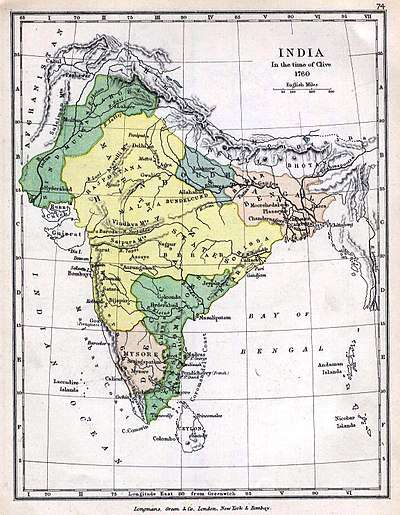
One of the foremost commanders of the Maratha Empire, he participated in the great victory near Delhi in 1737, and the defeat of the Nizam at Tal Bhopal in 1738. He also wrested Bassein from the Portuguese in 1739. He received Rampura, Bhanpura and Tonk in 1743, for the assistance given to Madhosingh I of Jaipur in his contest with Ishwari Singh. Granted an Imperial Sardeshmuckhi for Chandore, for his gallantry in the Rohilla campaign of 1748. From 1748 onwards, Malhar Rao Holkar’s position in Malwa became firm and secure. He became ‘Kingmaker’ in Northern and Central India and master of an extensive territory lying on both the sides of the Narmada as well as Sahyadri.
Malharrao Holkar, Jayappa Shinde, Gangadhar Tatya, Tukojirao Holkar, Khanderao Holkar went to help Safdarjung against Shadulla Khan, Ahmed Khan Bangash, Mohamud Khan, Bahadur Khan Rohilla as per the directions of Peshwa Balaji Bajirao. In the Battle of Fatthegad and Farukhabad, they defeated the Rohillas and Bangash (March 1751-April 1752). When Mughal Emperor came to know that Ahmed Shah Abdali had attacked Punjab in December 1751, he asked Safdarjung to make peace with Rohillas and Bangash. On 12 April 1752 Safdarjung agreed to help Marathas but the Emperor didn’t ratify the agreement and instead signed a treaty with Ahmed Shah Abdali on 23 April 1752. At the same time, the Peshwa asked Malharrao Holkar to return to Pune as Salabat Khan had attacked the city.
The Marathas besieged Kumher Fort from 20 January to 18 May 1754. The war continued for about four months. During the war Khanderao Holkar, son of Malhar Rao Holkar, was one day inspecting his army in an open palanquin, when he was fired upon from the fort. The cannonball hit and killed him on 24 March 1754. Malhar Rao was infuriated by the death of his only son and wanted to take revenge. He vowed that he would cut off the head of Maharaja Suraj Mal and throw the soil of fort into Yamuna after destroying it. The Marathas increased pressure and Suraj Mal defended pacifly, but Suraj Mal was isolated as no other ruler was ready to help him. At this moment, Maharaja Suraj Mal was counseled by Maharani Kishori, who assured him not to worry and started diplomatic efforts.
Feroze Jung III, aided by the Marathas led by Malhar Rao Holkar, defeated Safdarjung. At this the Emperor collected a large army and camped at Sikandarabad. On the other hand, the Maratha chieftain Sadashivrao Bhau, Malhar Rao Holkar and 2,000 Maratha's and their ally Feroze Jung III routed Imperial Mughal Army of the Mughal Emperor Ahmad Shah Bahadur at the First Battle of Sikandarabad (1754). The Emperor left his mother, wives and a retinue of 8,000 women behind and fled to Delhi.
She contacted Diwan Roop Ram Katara. She knew that there were differences between Malharrao Holkar and Jayappa Sindhia and that Jayappa Sindhia was very firm in his determinations. She advised Maharaja Suraj Mal to take advantage of mutual differences within Marathas. Diwan Roop Ram Katara was a friend of Jayappa Sindhia. She requested Diwan Roop Ram Katara to take a letter from Maharaja Suraj Mal proposing a treaty. Jayappa Sindhia assured Suraj Mal of assistance and contacted Raghunathrao. Raghunathrao in turn advised Holkar to sign a treaty with Suraj Mal. Malhar Rao Holkar assessed the situation and consented for the treaty due to possibility of isolation. This led to a treaty between both rulers on 18 May 1754. This treaty proved very beneficial for Maharaja Suraj Mal.[5]
Malharrao Holkar, Raghunathrao, Shamsher Bahadur, Gangadhar Tatya, Sakharambapu, Naroshankar and Maujiram Bania attacked Delhi on 11 August 1757 and defeated Najib Khan and Ahmed Khan became the Mir Bakshi in his place. In March 1758, they conquered Sarhind. On 20 April 1758, Malharrao Holkar and Raghunathrao attacked and conquered Lahore. Tukojirao Holkar conquered Attock. Sabaji Scindia, Vitthal Shivdev met them at Peshawar. Raghunathrao and Malharrao Holkar returned from Punjab.
He was raised to the rank of Subedar in 1757.
Malhar Rao Holkar was defeated decisively by the cavalry of the Durrani Empire led by Jahan Khan at the Second Battle of Sikandarabad (1760)
Third Battle of Panipat
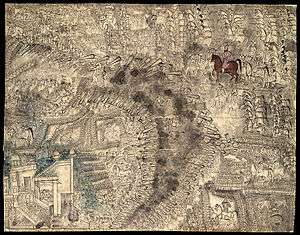
It is alleged that he fled the battle-field in the Third Battle of Panipat thanks to Shuja-ud-Daulah, who owed him a favour, even though the nawab of Awadh was fighting against the marathas.[7] It is written by many historians that he fought courageously in the battle-field. It is also written that Sadashivrao Bhau had entrusted him the job of saving Parvatibai as soon as told to do so. When Vishwasrao was killed and Sadashivrao Bhau felt they were about to be defeated he sent a message to Malharrao to immediately act as per directions and leave the battlefield. Malharrao acted as per the directions of Sadashivrao and saved Parvatibai. Malharrao was considered to be the right-hand man of Peshwa. Others who retreated from this battle were Mahadji Shinde and Nana Phadnawis.
Death
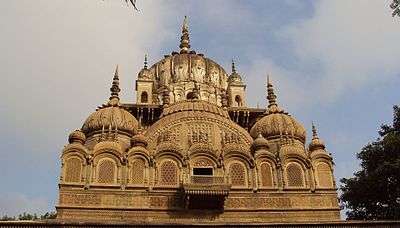
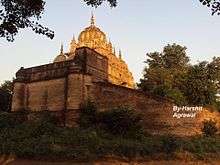
He died at Alampur, 20 May 1766. His only son Khanderao Holkar had already died in 1754 during the seize of Kumher against the Jat maharaja Suraj Mal of Bharatpur State. After his son Kanderao's death in 1754, Malhar Rao prevented his wife Ahilya Bai Holkar from committing sati.[8] Malhar Rao's grandson and Khanderao's young son Male Rao Holkar became the ruler of Indore in 1766, under the regentship of Ahilyabai, but he too died within few months in 1767. Ahilyabai became the ruler of Indore after the death of her only son with Khanderao. He is considered as one of the architects of Maratha control over India.[9][10][11]
His daughter-in-law Maharani Ahilya Bai Holkar built his samadhi Chhatri, at the spot of his cremation, at Alampur of Lahar in Bhind district of Madhya Pradesh state.[12][13]
Notes and references
- ↑ Holkars of Indore Archived 30 October 2013 at the Wayback Machine.
- ↑ Ramusack, Barbara N. (2004). The Indian Princes and their States. The New Cambridge History of India. Cambridge University Press. p. 35. ISBN 9781139449083.
- ↑ Jones, Rodney W. Urban Politics in India: Area, Power, and Policy in a Penetrated System. University of California Press. p. 25.
- 1 2 Gordon, Stewart (1993). The Marathas 1600-1818. 2. Cambridge University Press. pp. 117–118. ISBN 9780521268837.
- ↑ Dr. Prakash Chandra Chandawat: Maharaja Suraj Mal aur unka yug, Jaypal Agencies Agra, 1982, Pages 110-118
- ↑ S. M. Ikram (1964). "XIX. A Century of Political Decline: 1707–1803". In Ainslie T. Embree. Muslim Civilization in India. New York: Columbia University Press. Retrieved 5 November 2011.
- ↑ Torri, Michelguglielmo (2007). Storia dell'India (1. ed. nella Biblioteca storica Laterza. ed.). Bari: GLF editori Laterza. p. 332. ISBN 978-88-420-8283-5.
- ↑ Images of Women in Maharashtrian Literature and Religion, edited by Anne Feldhaus, pp185-186
- ↑ Advanced Study in the History of Modern India 1707-1813, by Jaswant Lal Mehta, pp606
- ↑ Omkareshwar and Maheshwar: Travel Guide, p60
- ↑ Indian States: A Biographical, Historical, and Administrative Survey, by R. V. Solomon, J. W. Bond, p.72
- ↑ History of Bhind district
- ↑ India Govt tender for the improvement of Malhar Rao Holkar's Chhatri at Alampur
Further reading
- Hindustancha Yugpurush Malharrao Holkar By Madhukar Salgare - 2009(Marathi)
- Subhedar Thorale Malharrao Holkar Yanche Charitra By M.M. Atre - 1893 (Marathi)
- Peshwa Maratha Relations and Malharrao Holkar By N.N. Nagarale 1989 (English)